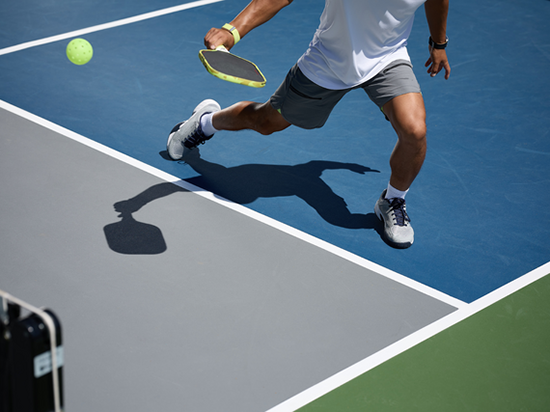 Experts at UAB provide guidance on how to prevent pickleball injury.Pickleball has become one of the fastest-growing sports in America, with the number of players rising from 4.8 million in 2021 to 8.9 million in 2023. Pickleball is popular among all age levels, with adults over 55 making up the largest demographic of pickleball players. With the sport’s increase in popularity comes an increase in pickleball-related injuries. Experts at the University of Alabama at Birmingham Department of Orthopaedic Surgery say there are steps people can take to keep themselves safe while playing this sport.
Experts at UAB provide guidance on how to prevent pickleball injury.Pickleball has become one of the fastest-growing sports in America, with the number of players rising from 4.8 million in 2021 to 8.9 million in 2023. Pickleball is popular among all age levels, with adults over 55 making up the largest demographic of pickleball players. With the sport’s increase in popularity comes an increase in pickleball-related injuries. Experts at the University of Alabama at Birmingham Department of Orthopaedic Surgery say there are steps people can take to keep themselves safe while playing this sport.
According to a recent study, there was a 90-fold increase in pickleball-related fractures, with a noticeable surge from 2020 onward where fractures doubled. From 2010 to 2019, greater than 85 percent of pickleball-related injuries were in individuals over the age of 60 and most were non-life-threatening injuries, according to a study.
Common pickleball-related injuries
“The most common injuries are muscle strains and ligament sprains,” said Thomas Evely, D.O., an orthopedist at UAB Sports and Exercise Medicine. “Pickleball requires quick movement and balance that can lead to acute injuries from fall or overuse-type injuries.”
Some common pickleball-related injuries include:
- Ankle injuries: Quick lateral movements and sudden stops commonly cause ankle strains. Repetitive stress can lead to Achilles tendonitis, an overuse injury affecting the tendon connecting the calf muscle to the heel bone.
- Knee pain: The sport’s frequent knee bending and twisting can strain the joints and exacerbate preexisting arthritis. This motion places stress on the lower back.
- Hamstring injuries: Sprinting and abrupt direction changes can lead to hamstring strains.
- Elbow pain: Repetitive stress on the elbow can cause “pickleball elbow,” similar to tennis elbow, affecting the outer elbow.
Injury prevention
“Taking steps to avoid injuries is crucial for several reasons,” Evely said. “By preventing injuries, you can prevent pain and long-term damage to muscles, joints and bones; minimize downtime and continue to stay active in the sport; perform better; and enjoy the game more.”
Strength and conditioning: Regular strength training and conditioning exercises can help prevent injuries. Focus on strengthening core, legs and upper body.
Warm up and cool down: Always start with a proper warmup that last approximately five to 10 minutes. This warmup should include stretches to get the blood flowing to the joints and muscles. After playing, finish with a cool-down routine that incorporates walking and stretching.
Some of Evely’s recommended stretches include:
- Hamstring stretch: Stand on one leg, extend the other leg straight out in front of you, and lean forward gently.
- Quadriceps stretch: Stand on one leg, pull the other foot toward your buttocks, and hold.
- Calf stretch: Place your hands against a wall, extend one leg back, and press the heel down.
- Shoulder stretch: Cross one arm over your chest, and use the other arm to gently press it closer.
- Hip flexor stretch: Kneel on one knee with the other foot in front, and push your hips forward gently.
Stay hydrated: Drink plenty of fluids before and after matches. Without proper hydration, the body will not be able to regulate heat properly.
Use proper equipment: Wear court shoes designed for lateral movement and support. Tennis shoes or pickleball-specific shoes provide good grip and cushioning. When choosing a paddle, individuals should get a paddle with a grip size that feels the most comfortable to them. If a grip is too large or too small, this could strain the muscles and lead to wrist or elbow injuries. A professional at a sporting goods store can help individuals find the right paddle for their specific needs.
Techniques: Learn and use proper techniques for hitting, serving and moving on the court to reduce stress on the body. Taking a few pickleball lessons with an expert can help individuals learn the proper techniques to avoid injury.
Rest and recovery: Do not overtrain. Take time to rest and recover between sessions to avoid overuse injuries.
Injury response
If injured while playing pickleball, take some time away from the sport to allow the injury to heal. For minor injuries, experts recommend treating the injury through rest, ice and nonsteroidal anti-inflammatory medications. However, if an injury is more severe such as a broken bone or if pain persists, consult with a health care professional.
Recovery times for pickleball-related injuries vary depending on the type and severity of the injury. Minor injuries might heal in a few days to weeks, while more severe injuries could take months depending on the severity.
“In the event of an emergency, you should seek immediate medical assistance,” Evely said. “For the muscle and joint pains, our team at UAB Orthopaedics is here to evaluate your injury and develop a patient-centered treatment plan to help you get back on the court safely.”
To make an appointment with UAB Sports and Exercise Medicine, visit uabmedicine.org to book an appointment online or call 205-930-8339.